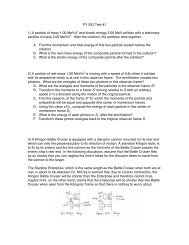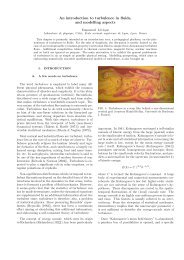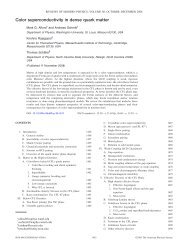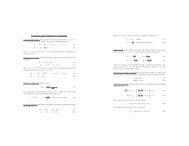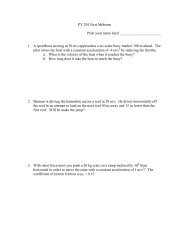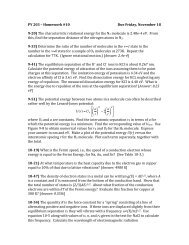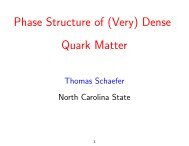The Twin Paradox
The Twin Paradox
The Twin Paradox
You also want an ePaper? Increase the reach of your titles
YUMPU automatically turns print PDFs into web optimized ePapers that Google loves.
<strong>The</strong> <strong>Twin</strong> <strong>Paradox</strong><br />
We would like to clarify the twin paradox using space time diagrams. This is also a<br />
nice exercise in drawing space time diagrams. We consider two observers: S and S’,<br />
where S’ is moving with velocity 0.625c relative to S.<br />
We will use Lorentz transformations to help us draw the diagrams correctly. We start<br />
with the S coordinate system (x, t). <strong>The</strong> transformation from S to S’ is<br />
x ′ = γ(x − βct), (1)<br />
ct ′ = γ(ct − βx), (2)<br />
where β = v/c and γ = 1/(1 − β 2 ) 1/2 . <strong>The</strong> t ′ axis corresponds to x ′ = 0, so ct = x/β.<br />
<strong>The</strong> x ′ axis satisfies t ′ = 0 and ct = βx. <strong>The</strong> two slopes are inversely proportional. We<br />
have<br />
t<br />
t’<br />
x’<br />
In order to find the units of S’ in the S-system we use the inverse Lorentz transformation<br />
x = γ(x ′ + βct ′ ), (3)<br />
ct = γ(ct ′ + βx ′ ). (4)<br />
<strong>The</strong> unit on the t ′ axis is (x ′ , ct ′ ) = (0, 1). This corresponds to (x, ct) = (γβ, γ).<br />
Analogously, (x ′ , ct ′ ) = (1, 0) is (x, ct) = (γ, γβ). For arbitrary β = v/c these curves<br />
are hyperbolas. <strong>The</strong> intersection of the hyperbolas with the S and S’ axes fixes the<br />
units.<br />
x<br />
1
(βγ,γ)<br />
(γ,βγ)<br />
(0’,1’)<br />
(0,1)<br />
(1’,0’)<br />
(1,0)<br />
Now we can draw an equal time line in S through the point (x, ct) = (0, 1). This is a<br />
line parallel to the x-axis. We can also draw an equal time line in S’ through the point<br />
(x ′ , ct ′ ) = (0, 1). This line is parallel to the x ′ -axis.<br />
t = const<br />
t’= const<br />
We can see that in S, the point (x, ct) = (0, 1) is at equal time to (x ′ , ct ′ ) = (0, 1/γ).<br />
Analogously, the point (x ′ , ct ′ ) = (0, 1) in S’ is at equal time (in S’) to (x, ct) = (0, 1/γ).<br />
For β = 0.625 we have γ = 1.28 and 1/γ = 0.78.<br />
2
t = 1.00<br />
t = 0.78<br />
t’= 0.78<br />
t’= 1.00<br />
<strong>The</strong> situation is completely symmetric. Both observers conclude that it is the other<br />
clock that is running slow (the other clock is showing ct = 0.78 when their own clock<br />
shows ct = 1). <strong>The</strong>re is no paradox, because there are (effectively) more than two clocks<br />
involved. Both S and S’ have sets of synchronized clocks, and comparisons between S<br />
and S’ involve clocks that are at the same space time point. <strong>The</strong> worldlines of clocks<br />
are shown as lines with arrows.<br />
t = 1.00<br />
t’= 1.00<br />
t = 0.78<br />
t’= 0.78<br />
3
Finally, we focus on the two clock comparisons that cause both S and S’ to conclude<br />
that the other clock is running slow.<br />
t = 1.00<br />
t’= 1.00<br />
t = 0.78<br />
t’= 0.78<br />
4
<strong>The</strong> <strong>Twin</strong> <strong>Paradox</strong>, revisited<br />
<strong>The</strong> original twin paradox is resolved by the observation that there are more than two<br />
clocks that are being compared. As a result there is no sense in which the clocks in S<br />
or S’ are “really” slower. S and S’ are completely symmetric<br />
Now imagine that we try to reduce the twin paradox to the comparison of just two<br />
clocks. For this purpose imagine that both S and S’ have only one clock, located as<br />
x = 0 and x ′ = 0, respectively. Both observers send out a light signal (dark red and<br />
dark green dashed lines) for every tick of their clock. <strong>The</strong> figure shows that the situation<br />
is still symmetric: both observers conclude that the other clock is slow (the light signal<br />
corresponding to tick number n of the other clock arrives after the local clock has sent<br />
out the n’th signal). Note that this effect is more than just time dilation – it also<br />
involves the extra delay due to the travel time of the light signal. <strong>The</strong> combination of<br />
these two effects is called the Doppler effect.<br />
(0,3)<br />
(0,2’)<br />
(0,2)<br />
(0,1)<br />
(0,1’)<br />
5
Now imagine that S’ starts to decelerate at some point, and then reverses direction<br />
until he reaches the velocity −0.625c. <strong>The</strong>n both S and S’ will start to pick the light<br />
signals of the other clock at an increased rate. When the word lines of the two clocks<br />
intersect there is no time delay anymore. In the figure we can see that S’ has collected<br />
three “ticks” sent by S, whereas S barely receives two ticks. <strong>The</strong> situation is no longer<br />
symmetric, the S’ clock is “really” slower. This is possible because S and S’ are no<br />
longer equivalent. S is an inertial observer, whereas S’ undergoes acceleration and is<br />
not an inertial observer.<br />
(0,3)<br />
(0,2’)<br />
(0,2)<br />
(0,1)<br />
(0,1’)<br />
6



![Page 1 PY 203 Homework #7 Due Friday, October 21 7-2] A particle ...](https://img.yumpu.com/50749809/1/190x245/page-1-py-203-homework-7-due-friday-october-21-7-2-a-particle-.jpg?quality=85)
